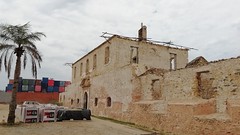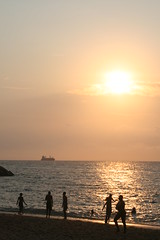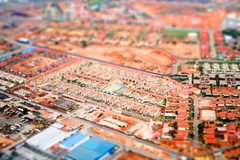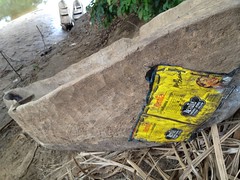Luanda
Luanda (English: /luˈændə-ˈn-/, Portuguese: [luˈɐ̃dɐ]) is the capital and largest city in Angola. It is Angola's primary port, and its major industrial, cultural and urban centre. Located on Angola's northern Atlantic coast, Luanda is Angola's administrative centre, its chief seaport, and also the capital of the Luanda Province. Luanda and its metropolitan area is the most populous Portuguese-speaking capital city in the world and the most populous Lusophone city outside Brazil, with over 8.3 million inhabitants in 2020 (a third of Angola's population).
Among the oldest colonial cities of Africa, it was founded in January 1576 as São Paulo da Assunção de Loanda by Portuguese explorer Paulo Dias de Novais. The city served as the centre of the slave trade to Brazil before its prohibition. At the start of the Angolan Civil War in 1975, most of the white Portuguese left as refugees, principally for Portugal. Luanda's population increased greatly from refugees fleeing the war, but its infrastructure was inadequate to handle the increase. This also caused the exacerbation of slums, or musseques, around Luanda. The city is undergoing a major reconstruction, with many large developments taking place that will alter its cityscape significantly.
The industries present in the city include the processing of agricultural products, beverage production, textile, cement, new car assembly plants, construction materials, plastics, metallurgy, cigarettes and shoes. The city is also notable as an economic centre for oil, and a refinery is located in the city. Luanda has been considered one of the most expensive cities in the world for expatriates. The inhabitants of Luanda are mostly members of the ethnic group of the Ambundu, but in recent times there has been an increase of the number of the Bakongo and the Ovimbundu. There exists a European population, consisting mainly of Portuguese. Luanda was the main host city for the matches of the 2010 African Cup of Nations.
History
Portuguese colonization
Portuguese explorer Paulo Dias de Novais founded Luanda on 25 January 1576 as "São Paulo da Assumpção de Loanda", with one hundred families of settlers and four hundred soldiers. In 1618, the Portuguese built the fortress called Fortaleza São Pedro da Barra, and they subsequently built two more: Fortaleza de São Miguel (1634) and Forte de São Francisco do Penedo (1765–66). Of these, the Fortaleza de São Miguel is the best preserved.
Luanda was Portugal's bridgehead from 1627, except during the Dutch rule of Luanda, from 1640 to 1648, as Fort Aardenburgh. The city served as the centre of slave trade to Brazil from circa 1550 to 1836. The slave trade was conducted mostly with the Portuguese colony of Brazil; Brazilian ships were the most numerous in the port of Luanda. This slave trade also involved local merchants and warriors who profited from the trade. During this period, no large scale territorial conquest was intended by the Portuguese; only a few minor settlements were established in the immediate hinterland of Luanda, some on the last stretch of the Kwanza River.
In the 17th century, the Imbangala became the main rivals of the Mbundu in supplying slaves to the Luanda market. In the 1750s, between 5,000 and 10,000 slaves were annually sold. By this time, Angola, a Portuguese colony, was in fact like a colony of Brazil, paradoxically another Portuguese colony. A strong degree of Brazilian influence was noted in Luanda until the Independence of Brazil in 1822.
In the 19th century, still under Portuguese rule, Luanda experienced a major economic revolution. The slave trade was abolished in 1836, and in 1844, Angola's ports were opened to foreign shipping. By 1850, Luanda was one of the greatest and most developed Portuguese cities in the vast Portuguese Empire outside Continental Portugal, full of trading companies, exporting (together with Benguela) palm and peanut oil, wax, copal, timber, ivory, cotton, coffee, and cocoa, among many other products. Maize, tobacco, dried meat, and cassava flour are also produced locally. The Angolan bourgeoisie was born by this time.
In 1889, Governor Brito Capelo opened the gates of an aqueduct which supplied the city with water, a formerly scarce resource, laying the foundation for major growth.
Estado Novo
Throughout Portugal's dictatorship, known as the Estado Novo, Luanda grew from a town of 61,208 with 14.6% of those inhabitants being white in 1940, to a wealthy cosmopolitan major city of 475,328 in 1970 with 124,814 Europeans (26.3%) and around 50,000 mixed race inhabitants (10.5%).
Like most of Portuguese Angola, the city of Luanda was not affected by the Portuguese Colonial War (1961–1974); economic growth and development in the entire region reached record highs during this period. In 1972, a report called Luanda the "Paris of Africa".
Independence
By the time of Angolan independence in 1975, Luanda was a modern city. The majority of its population was African, but it was dominated by a strong minority of white Portuguese origin.
After the Carnation Revolution in Lisbon on April 25, 1974, with the advent of independence and the start of the Angolan Civil War (1975–2002), most of the white Portuguese Luandans left as refugees, principally for Portugal, however many travelled over land to South Africa.
The large numbers of skilled technicians among the force of Cuban soldiers sent in to support the Popular Movement for the Liberation of Angola (MPLA) government in the Angolan Civil War were able to make a valuable contribution to restoring and maintaining basic services in the city.
In the following years, however, slums called musseques — which had existed for decades — began to grow out of proportion and stretched several kilometres beyond Luanda's former city limits as a result of the decades-long civil war, and because of the rise of deep social inequalities due to large-scale migration of civil war refugees from other Angolan regions. For decades, Luanda's facilities were not adequately expanded to handle this huge increase in the city's population.
21st century
After 2002, with the end of the civil war and high economic growth rates fuelled by the wealth provided by the increasing oil and diamond production, major reconstruction started.
Luanda has also become one of the world's most expensive cities.
The central government supposedly allocates funds to all regions of the country, but the capital region receives the bulk of these funds. Since the end of the Angolan Civil War (1975–2002), stability has been widespread in the country, and major reconstruction has been going on since 2002 in those parts of the country that were damaged during the civil war.
Luanda has been of major concern because its population had multiplied and had far outgrown the capacity of the city, especially because much of its infrastructure (water, electricity, roads etc) had become obsolete and degraded.
Luanda has been undergoing major road reconstruction in the 21st century, and new highways are planned to improve connections to Cacuaco, Viana, Samba, and the new airport.
Major social housing is also being constructed to house those who reside in slums, which dominate the landscape of Luanda. A large Chinese firm has been given a contract to construct the majority of replacement housing in Luanda. The Angolan minister of health recently stated poverty in Angola will be overcome by an increase in jobs and the housing of every citizen.
Geography
Human geography
Luanda is divided into two parts, the Baixa de Luanda (lower Luanda, the old city) and the Cidade Alta (upper city or the new part). The Baixa de Luanda is situated next to the port, and has narrow streets and old colonial buildings. However, new constructions have by now covered large areas beyond these traditional limits, and a number of previously independent nuclei — like Viana — were incorporated into the city.
Metropolitan Luanda
Until 2011, the former Luanda Province comprised what now forms five municipalities. In 2011 the Province was enlarged by the addition of two additional municipalities transferred from Bengo Province, namely Icolo e Bengo, and Quiçama. Excluding these additions, the five municipalities comprise Greater Luanda:
| Name | Area in km2 | Population Census 2014 | Population Estimate 2019 |
|---|---|---|---|
| Belas | 1,046 | 1,071,046 | 1,271,854 |
| Cacuaco | 312 | 1,077,438 | 1,279,488 |
| Cazenga | 37 | 880,639 | 1,045,722 |
| Luanda (city) | 116 | 2,165,867 | 2,571,861 |
| Viana | 693 | 1,600,594 | 1,900,688 |
| Totals | 2,204 | 6,795,584 | 8,069,613 |
Two new municipalities have been created within Greater Luanda since 2017: Talatona and Kilamba-Kiaxi
Districts
The city of Luanda is divided in six urban districts: Ingombota, Angola Quiluanje, Maianga, Rangel, Samba and Sambizanga.
In Samba and Sambizanga, more high-rise developments are to be built. The capital Luanda is growing constantly - and in addition, increasingly beyond the official city limits and even provincial boundaries.
Luanda is the seat of a Roman Catholic archbishop. It is also the location of most of Angola's educational institutions, including the private Catholic University of Angola and the public University of Agostinho Neto. It is also the home of the colonial Governor's Palace and the Estádio da Cidadela (the "Citadel Stadium"), Angola's main stadium, with a total seating capacity of 60,000.
Demographics
| Year | Population |
|---|---|
| 1970 (Census) | 475,328 |
| 2014 (Census) | 6,760,439 |
| 2018 (Projection) | 7,774,200 |
The inhabitants of Luanda are primarily members of African ethnic groups, mainly Ambundu, Ovimbundu, and Bakongo. The official and the most widely used language is Portuguese, although several Bantu languages are also used, chiefly Kimbundu, Umbundu, and Kikongo.
The population of Luanda has grown dramatically in recent years, due in large part to war-time migration to the city, which is safe compared to the rest of the country. In 2006, however, Luanda saw an increase in violent crime, particularly in the shanty towns that surround the colonial urban core.
There is a sizable minorit…

















